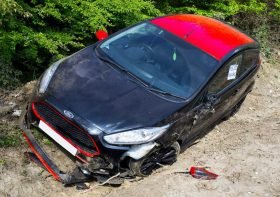6 Ways Car Accidents Can Disrupt Your Creative Life

Your creative life relies on passion, inspiration, and the ability to focus. But what happens when something unexpected, like a car accident, interrupts that flow?
Car accidents are traumatic experiences that can reverberate throughout every aspect of life, including the creative process. From changes in mood to disruptions in routine, the effects can be as profound as they are varied. Understanding these impacts can help you prepare for and mitigate the fallout.
Contents
Emotional Turmoil and Creative Blocks
The emotional aftermath of a car accident can be significant. Feelings of anxiety, fear, and depression often arise, making it difficult to channel thoughts into creative endeavors. The initial shock of the incident can lead to a mental fog, obstructing the natural flow of ideas.
This emotional turmoil is not just a transient state but can linger. According to the American Psychological Association, car accidents are linked to post-traumatic stress disorder (PTSD), which can further stifle creativity.
Artists, writers, and musicians depend on their emotional states to produce work. If creativity feels overshadowed by emotional pain, the quality and quantity of output may suffer.
The disruption in emotional stability can morph into a full-fledged creative block, making the act of creation feel overwhelming and frustrating. For those involved in an accident, focusing on personal recovery becomes the priority, often pushing creative pursuits to the back burner.
Physical Limitations and Their Impact on Creativity
Injuries sustained during a car accident can result in physical limitations that impede creative expression. Whether it’s chronic pain, immobility, or fatigue, these ailments can debilitate an artist’s or creator’s ability to perform. Pain and discomfort demand attention and can drain energy reserves needed for creative tasks. When your body feels like a constraint rather than a vessel for expression, the creative process suffers drastically.
Many creators thrive on routine, and a sudden change due to physical limitations can disrupt that rhythm. Activities that once inspired, such as visiting galleries, meeting with peers, or attending creative workshops, may become challenging. Those who rely heavily on hands-on practices may find their levels of productivity severely reduced.
Disrupted Routines and Creative Output
Routines bring structure to creative endeavors, essential for maintaining momentum and inspiration. A car accident can disrupt these routines profoundly, forcing individuals to rethink their schedules and commitments. Driving to work or creative meetings is fundamental. Losing that ability means revising logistical aspects of life and reordering the rhythm of productivity.
Creative projects often require dedicated time, and when the unexpected occurs, priorities realign. Organizing everyday tasks around medical appointments, therapy sessions, or simply recovering from injuries can sideline creative projects. The emergence of new priorities can jeopardize deadlines, leading to increased stress and anxiety.
Financial Consequences and Stress
The financial stress following a car accident can be considerable. Medical bills, potential loss of income, and rehabilitation expenses may create an overwhelming burden. This financial strain can shift the focus from creative pursuits to worrying about monetary stability. Stress related to financial concerns can consume mental bandwidth, reducing the clarity and confidence needed to engage in creative work.
Many creators rely on their craft as a source of income. When the capacity to create is hindered due to personal disruptions caused by an accident, this can lead to further financial insecurity.
Seeking compensation for losses through avenues like Laredo Vehicle Collision Claims becomes a necessity and a creative obstacle that must be navigated concurrently with recovery. This dual focus on recovery and financial health can lead to burnout, rendering the creative process even more challenging.
Loss of Community and Isolation
A vital aspect of creative life involves interaction with others, be it through workshops, critiques, or collaborations. Car accidents can isolate individuals, cutting them off from their support networks. Losing touch with peers can exacerbate feelings of loneliness and discouragement. In a vibrant community, the exchange of ideas fosters creativity, while isolation can lead to stagnation and self-doubt.
The recovery timeline may necessitate time away from engaging social circles. Missing creative workshops or collaboration opportunities creates a feedback loop where isolation inhibits growth, leading to further disengagement. Those coping with the aftermath of an accident may withdraw from activities they once enjoyed, compounding the disruption of their creative life.
Motivation and the Creative Drive
The experience of a car accident often leaves individuals questioning their motivations and passions. What once felt urgent or vital can fade in the face of trauma, shifting priorities, and diminishing the drive to create. Emotional and physical recovery takes precedence, potentially overshadowing the intrinsic inspirations that motivate creative expression. This loss of motivation can ripple through projects, leading to major stalls in progress.
As creators reassess their passions, they may encounter a dip in their drive, leading them to explore new avenues or even rethink their identities. This period of exploration can sometimes yield positive growth. The frustration of interrupted creativity is never far away. Overcoming the hurdle of lost motivation requires significant effort, patience, and often support from others who can help rekindle that flame.
Understanding the complexities of how car accidents can disrupt one’s creative life is crucial for planning a recovery strategy that respects those challenges. Armed with knowledge, you can mitigate these impacts and navigate the post-accident landscape with renewed purpose.


